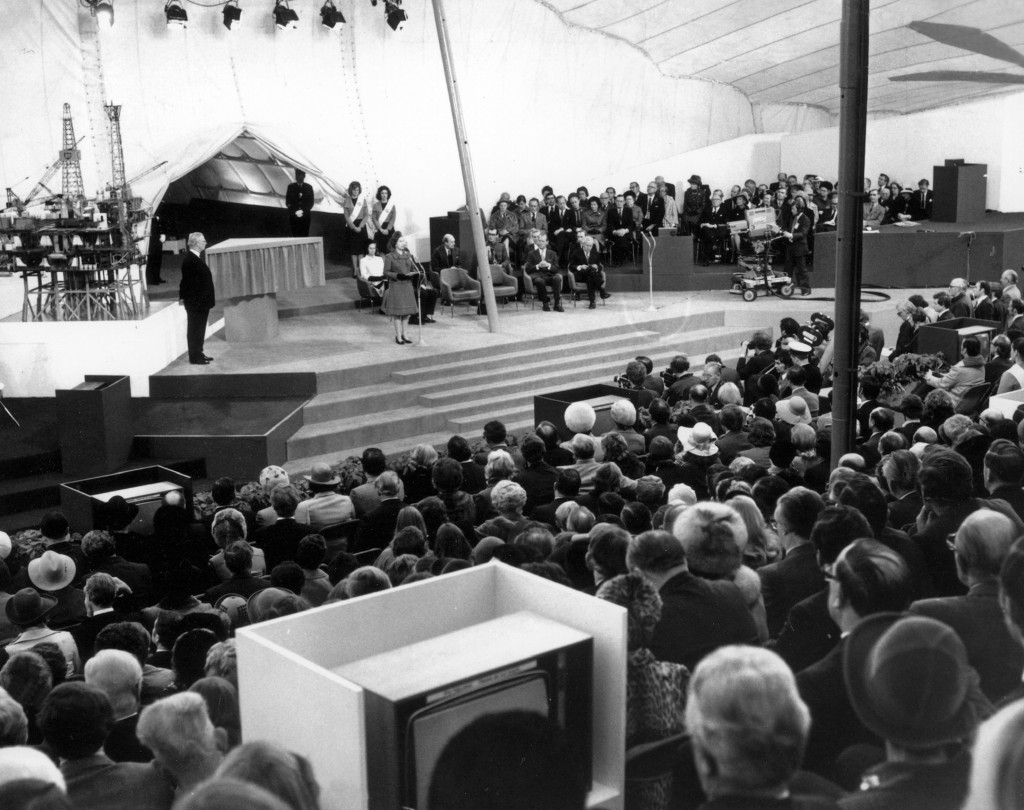
When young petroleum engineer Frank Musgrave stepped on board BP’s brand new Forties Alpha platform in the late summer of 1975, he was entirely focused on his role in getting the oil flowing, not on playing a part in a key period of British history.
“It was only when I saw the Queen, Prime Minister and dozens of other dignitaries in a marquee at our offices in Aberdeen, that I realised what a big deal Forties was for BP and for the country,” explained the oil industry veteran.
After spending his entire career with BP, Frank eventually retired in 2008 as HSE director for the North Sea.
In 1975, he was a 23-year-old completions specialist, responsible for the tubulars that would carry the oil from below the sea bed to Forties Alpha before it was pumped the 110 miles to the Scottish coastline at Cruden Bay, near Aberdeen, in September of that year.
November 3, 1975 was the day that Forties oil officially came ashore.
The Queen pressed the button in a big tent at Dyce, Aberdeen inaugurating the golden era of production that would transform the fortunes of the Granite City, swell the coffers of the Treasury and free the UK from threat of economic-blackmail by Middle Eastern states who until then, it was believed, would hold the country to ransom by turning the oil taps off. By 1979, Forties peaked at 500,000 barrels per day.
None of that was of huge concern to Frank, who had already spent many days offshore on Forties Alpha, dealing with the technical, crucial issue of sand production in the well.
“We were just so focussed on getting the job done. I came to Aberdeen in 1974, just before the jackets were installed on Forties. At that stage, time was money and there was complete attention on getting production going. By ’75 the pressure was mounting to deliver.
“We knew Forties was huge, but we had no idea how long the oil would last. It’s tribute to the ingenuity and effort of all those involved that there are still hydrocarbons being produced from Forties to this day. I don’t know how long Apache will keep it going, it must be a real challenge.”
Filling the Forties pipeline was a big job. The volume of oil required to pump through the pipe to shore and onward to the giant refinery in Grangemouth was vast. This all had to be in place ahead of the official ceremony.”
“It was a big challenge at the time,” recalled Frank.
“There was a big issue with beds on the platform because there were so many people out there all at the same time.”
Being young and with life to live, Frank chose to accept BP’s offer of a day’s extra holiday on November 3. It wasn’t to be, as he was asked to “volunteer” as coach-monitor on the big day to chaperone the hundreds of big wigs making their way to Aberdeen from Whitehall on the sleeper before being bused to Dyce.
“Security was tight. The police were worried about a bomb threat by the Tartan Army. We were running late and I remember nearly knocking Prime Minister Harold Wilson off his feet as I ran down the platform to escort my guests, who included Energy Secretary Anthony Wedgewood (Tony) Benn.
“He was keen on doing his man of the people bit and, nice guy that he was, he insisted on speaking to the porters and railwaymen at the station, while I was panicking about getting everyone back to the Skean Dhu hotel at Dyce.”
“Having all that oil right on our doorstep was incredibly important to the company and for Britain’s balance of payments. It was transformational for the country.
“But you never think: ‘I’m changing the world’, when you’re having a pint in the pub after work and making plans for the weekend.”
Since retiring, Frank continued with consultation work and supported his children’s passion for cross country skiing and maintaining the family home in Oyne, in Aberdeenshire. He is proud of the thousands of people who helped bring Forties oil ashore and is confident that the North Sea oil industry will endure.
“When I came back to the UK in the early 2000s, oil was $10 dollar per barrel. It was gloom and doom then. People will find ways to keep the industry going. There are big projects still out there such as Clair, Kraken and Mariner. I’m confident the industry will still be going in 30 to 40 years.”
Recommended for you
